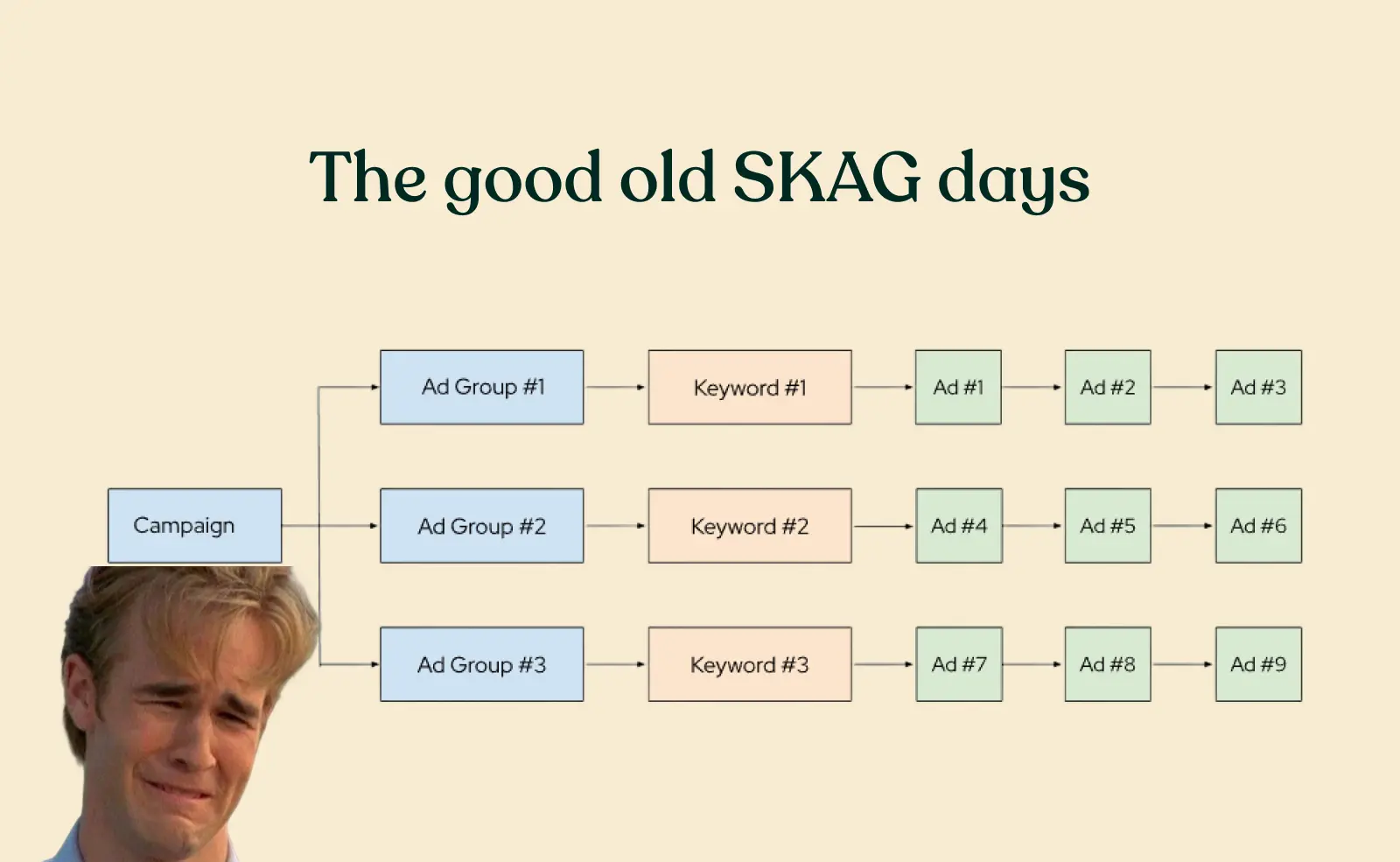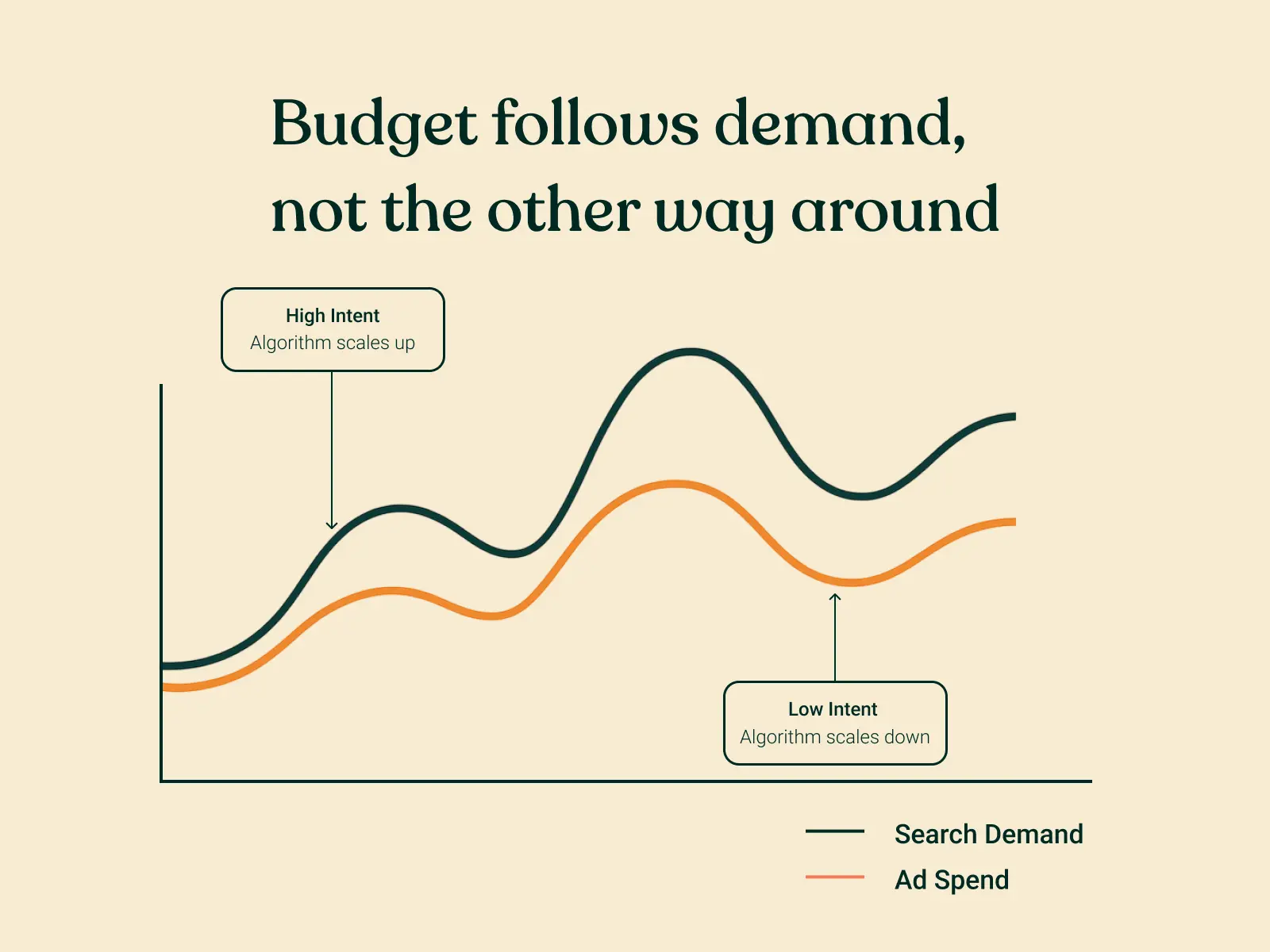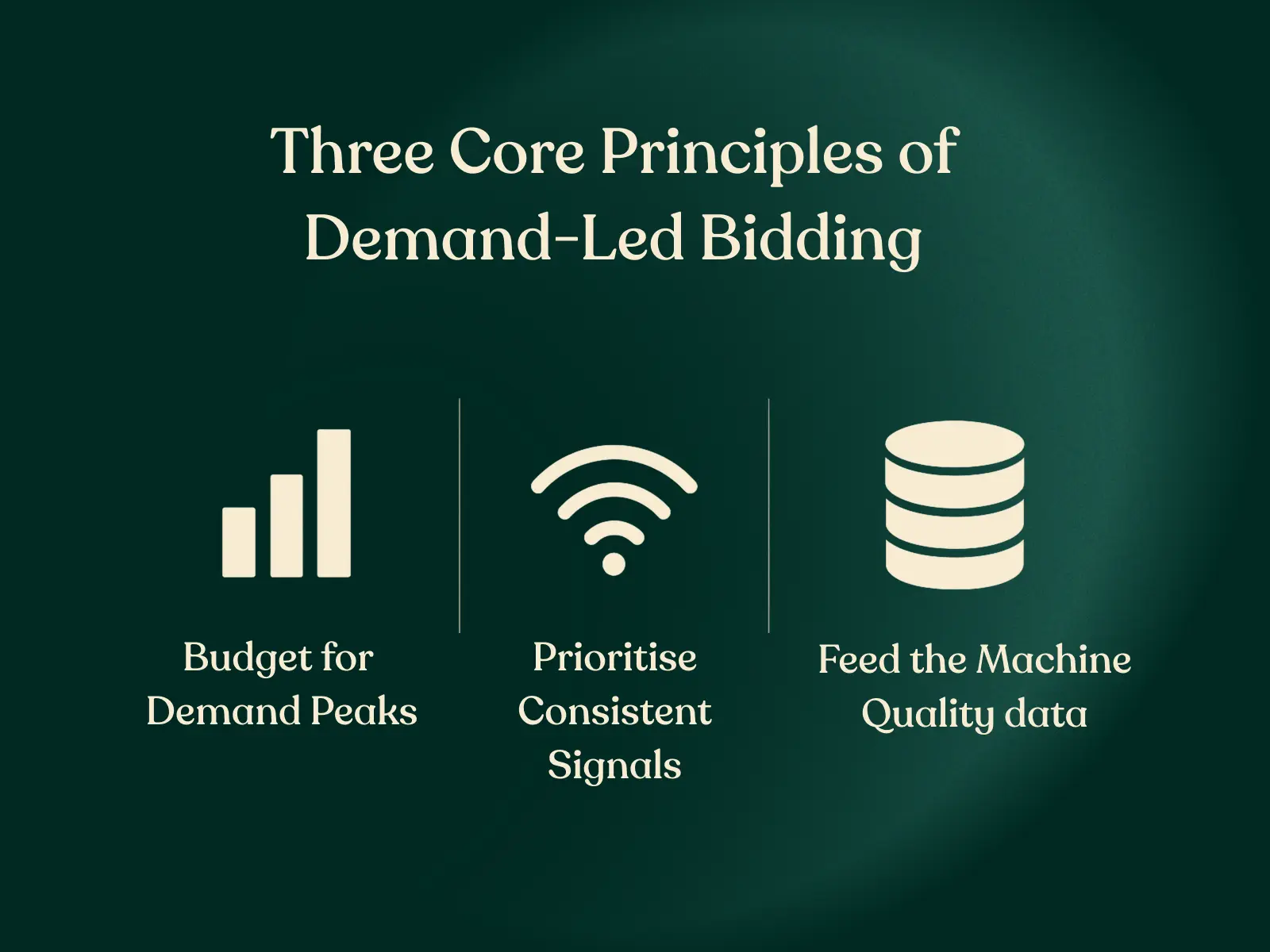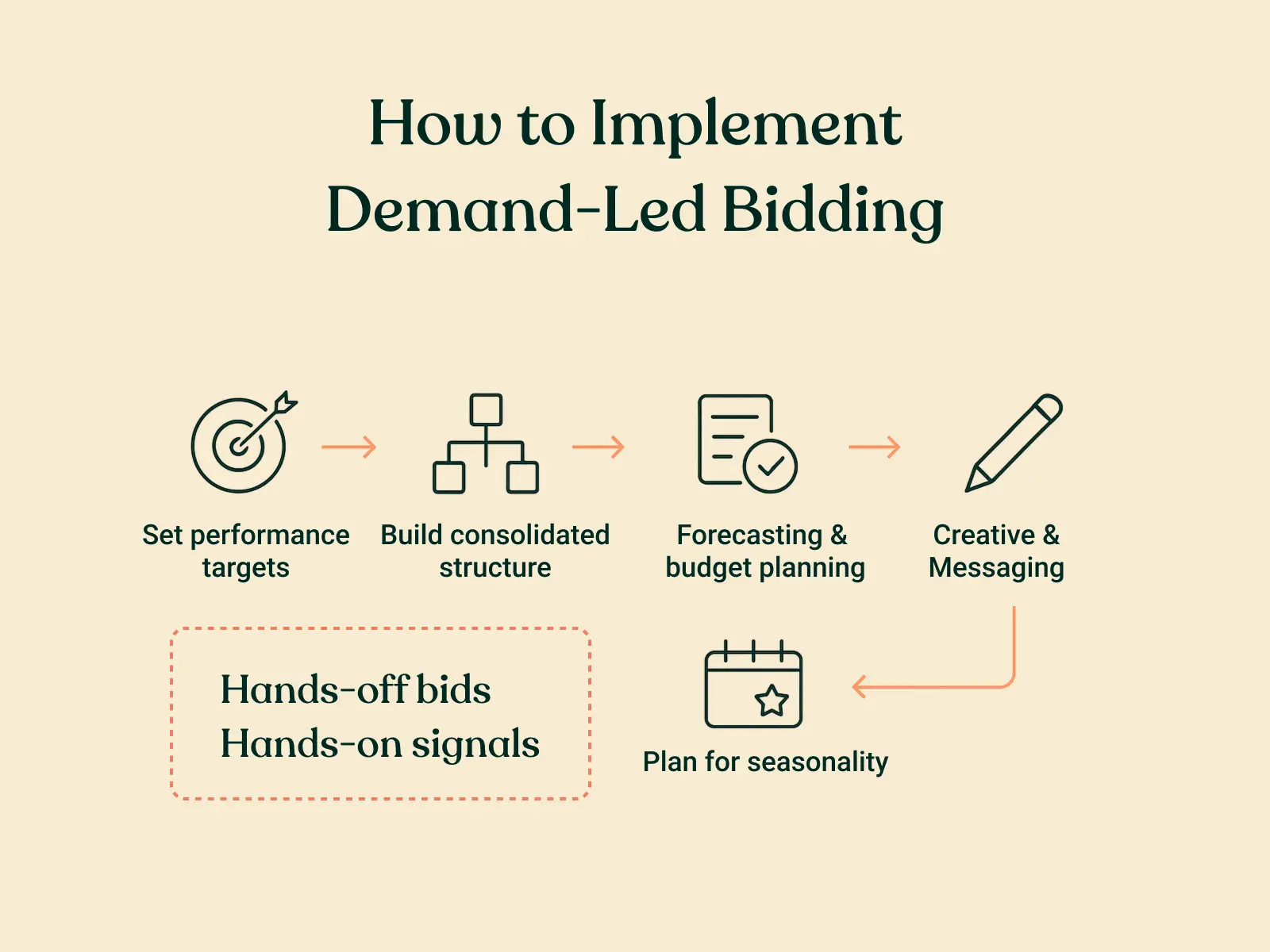
Demand-Led Bidding: Letting the Market Lead Your Google Ads Strategy
Google Ads has evolved from manual bidding to AI-driven, demand-led strategies. Success now comes from feeding the algorithm quality data, aligning spend with real-time demand, and focusing on metrics like MER and aCAC instead of rigid budgets.
In 2025, over 80% of all Google Ads accounts are using Smart Bidding as their default strategy.
Manual bidding, SKAGs, and expanded text ads now feel like relics of another era. Google Ads is no longer a channel for quick bid tweaks or reactionary optimisations.

Back when media buyers had more control over campaign delivery
Instead, we’ve entered an era of AI-driven, demand-led bidding, where success belongs to advertisers who trust the machine, feed it the right signals, and let demand, not instinct, dictate investment.
The Old Model: Reactive and Manual
For years, performance marketers reacted to every small metric shift in their Google Ads accounts.
A spike in CPC? Drop bids.
A dip in conversions? Cut spend.
A new converting term? SKAG it immediately.
This made sense when media buyers had control over every lever. But as automation took over, those levers disappeared behind Google’s algorithms. Trying to outsmart Smart Bidding by reverting to manual control doesn’t just slow you down, it makes you less competitive.
You might regain control over CPCs, but you lose your ability to compete in auctions where Google’s algorithm reacts faster, smarter, and with more data than any human can.
The result? Your CPCs look tidy, but your revenue target slips away.
The New Model: Demand-Led Bidding
Demand-led bidding is the idea that ad spend should ebb and flow with real-world market demand, not stick rigidly to a monthly budget cap.

Let the AI dictate budget distribution based on real-time market demand.
Instead of fighting to hit static spend targets, advertisers set efficiency metrics, like MER (Marketing Efficiency Ratio) or CAC (Customer Acquisition Cost), and allow Google’s algorithms to scale budgets dynamically based on market intent.
When search demand and conversion intent rise, Smart Bidding automatically increases spend.
When intent softens, it pulls back.
The key is to guide the machine, not micromanage it.
Why This Shift Makes Sense
Google Search Ads has never been a reactive channel, it’s a demand capture channel. Google largely doesn’t create demand; it lets you show up when it already exists.
Demand-led bidding acknowledges this. It’s about aligning your budgets, goals, and signals with the natural rhythm of the market, not arbitrary monthly caps.
Three Core Principles of Demand-Led Bidding
- Budget for Demand Peaks
Don’t strangle campaigns with daily or weekly caps. Instead, set flexible monthly (or even quarterly) budgets that can expand when the algorithm detects increased intent. - Prioritise Consistent Signals
Avoid reactive bid target changes. If your tROAS target is 300%, don’t tighten it because one campaign hit 295% yesterday. Give Google’s learning system time to optimise. - Feed the Machine Quality Data
Strong conversion tracking, CRM integration, offline conversion tracking, and first-party data are what power Smart Bidding. The machine can only optimise as well as the signals you give it.

3 core principles to demand-led bidding.
Learning From the Past: A BFCM Example
Take Black Friday / Cyber Monday 2024.
After Cyber Monday, many media buyers saw conversion rates dip and immediately pulled back on budgets to meet month-end caps. On paper, this made sense. But in reality, demand remained high which we validated through Google Trends throughout early December, and Google’s intent signals reflected it.
Had those accounts maintained flexible budgets and realistic efficiency targets, Smart Bidding would have kept pushing through that window of elevated intent.
Instead, spend was throttled too early, leaving significant revenue on the table.
The Missed Opportunity
In one BFCM account we reviewed, budgets were heavily decreased as soon as the sale ended, purely as a reaction to falling conversion rates. But when we overlaid search volume and click-through rates in early December, we found demand was still strong.
If the budget and targets had been adjusted to reflect post-sale historical trends rather than cut altogether, the algorithm would’ve continued investing efficiently through early December.
The result?
- Missed incremental revenue during a still-active buying period.
- Lost remarketing audience volume heading into Q1.
- A slower recovery curve when ramping budgets back up in January.
Demand-led bidding prevents this. It recognises that a short-term drop in efficiency doesn’t always mean reduced demand. Sometimes, it’s just market recalibration.
How to Implement Demand-Led Bidding
Demand-led bidding isn’t “hands off”, it’s hands in the right places.
Your focus shifts from controlling bids to managing signals, strategy, and market interpretation.

How to implement demand led bidding
1. Set the Right Performance Targets
Use metrics like tROAS, tCPA, or MER based on margin and profitability goals. Build campaign-level targets that align with these broader business metrics.
2. Build a Consolidated Account Structure
Simplify campaigns so the algorithm has enough data to optimise. Group similar products or audiences to strengthen signal density.
3. Maintain Clean Data and Tracking
Ensure conversions are tracked accurately and segmented by value. Integrate CRM and first-party customer data to enrich audience signals.
4. Plan for Seasonality
Adjust forecasts and targets for key sales periods or known demand drops. Smart Bidding can adapt fast, but proactive planning keeps efficiency high.
5. Continuously Review and Optimise Creatives
Feed fresh creative into Performance Max and Video campaigns. Google’s automation still relies on human creativity to find new angles and sustain engagement.
When to Step In: Human Intervention Still Matters
Even the smartest AI bidding algorithms can’t anticipate everything.
That’s why media buyers remain vital.
You’ll still need to step in when:
- Competitors make major pricing or creative shifts
- Supply or stock fluctuates unexpectedly
- Global events or regulations impact performance
Tools like seasonal bid adjustments and manual overrides exist for these moments — use them strategically, not emotionally.
Final Thoughts
Demand-led bidding represents the natural evolution of Google Ads strategy. It’s a mindset shift that rewards patience, signal quality, and strategic thinking over constant reaction.
In a world where automation outpaces human reflexes, marketers win not by pulling every lever, but by knowing which levers still matter.
Let the market lead.
Feed the machine.
And give your campaigns the space they need to grow.

Harry Taylor
Harry is our Senior Performance Manager with over 7+ years experience in paid media.
Like what you read?
Learn more about digital, creative and platform strategies below.